MONUMENTS
 Red
Fort
Red
Fort

The
Red Fort, with a circumference of over 2.2 kilometers, was laid out by the banks
of the Yamuna river in the 17th century. The Mughal emperor Shajahan built it
with the ambition of concentrating the Mughal power in one monument. Monument
is perhaps not the right word. A mini-city is more like it. Unfortunately for
the emperor, before he could move his capital from Agra to Shahjahanabad in
Delhi, he was taken a political prisoner by his son Aurangazeb. The fort is
a delight to one's imagination. Imagine the Naqqar Khana (Drum room) also called
Naubat Khana (Welcome Room), where once drums loudly heralded the arrival of
the emperor and the Diwan-e-Am (Hall of Public Audience) resounded with the
incantations of the people. Amazing, isn't it? There's more to see - Mumtaz
Mahal, Rang Mahal (Palace of Colours), Khas Mahal (Emperor's Palace), Diwan-e
Khas (Hall of Private Audience), the Hammam (bathing area) and Shah Burj.
The fort has two main entrances - Delhi Gate and Lahore Gate. The latter get
its name from the fact that it faces Lahore in Pakistan. It's entrance leads
to Delhi's most crowded bazaar, Chandni Chowk. A must see!
There is a Light and Sound Show every evening.
Summer timing:
Hindi - 7 pm to 8 pm, English - 8 pm to 9 pm
Winter timing:
Hindi - 6 pm to 7 pm, English - 7 pm to 8 pm

 Humayun's
Tomb
Humayun's
Tomb
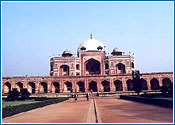
Humayun's
Tomb is probably one of the most innovative and experimental monuments of its
time, incorporating within it Indo-Islamic architectural styles. Hamida Bhanu
Begum (Haji Begum), Humayun's grieving widow built it in 1565-66. She is said
to have spent 15 lakh rupees on it. Humayun's Tomb shows a very remarkable Persian
influence, and art historians conjecture that this influence could probably
have its origin in Humayun's exile in Persia. The tomb, typical of a Persian
design, is a square building cut off at its corners to make it octagonal. It
started a whole new form of architecture, where tombs were built in the centre
of a four-portioned garden.
Another fact that is interesting is the double dome of the tomb. The tomb has
two domes, one below the other. This is yet another example of the engineering
brilliancy of the Mughals. To have a huge, inspiring dome from the exterior
would mean a much too large dome for the inside of the building. So there's
a lower, interior ceiling. And it makes any visitor very comfortable, who does
not have to deal with an intimidating hall.
There is an entrance in the south of the complex. It leads to the emperor's
tomb, which lies in the centre of a serene chamber. However, the actual resting
place of Humayun is directly beneath, in an underground chamber. Several royalties
of the Mughal family are buried in the mausoleum.
The tomb is open on all days of the week.

 Purana
Qila
Purana
Qila
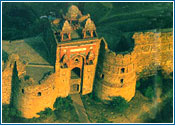
In
1538, the Mughal emperor Humayun laid the foundations of his city named Dinpanah,
or the Refuge of the Faithful. The inner citadel of this city is today called
Purana Qila or the Old Fort. An old fort, it is! One can almost smell the ancient
stories oozing from the corners of the fort. The site of the fort was also Indraprasta,
the capital of the famed warriors of the Mahabharata, the Pandavas. Excavations
near the eastern wall of the fort reveal that the site had been occupied since
1000 B.C. Archaeologists found painted grey ware pottery and other remains,
which date back to the Mahabharata. The Purana Qila has three gates - Humayun
Darwaza, Talaqi Darwaza and Bara Darwaza. The present entrance is the Bara Darwaza,
an imposing red sandstone gate on the western wall. Inside the Purana Qila is
the Sher Mandal, a two-storied octagonal pavilion in red sandstone, built by
Sher Shah. Humayun used it as a library after he captured the fort. However,
the Mandal is tragic, since it was here where the emperor is said to have tripped
on its tortuous stairs and tumbled to his death in 1556.

 Safdarjung's
Tomb
Safdarjung's
Tomb

Safdarjung's
Tomb is the last of the enclosed garden tombs in the tradition of Humayun's
tomb. It was built in 1753-54, for Safdarjung, the Prime Minister of Muhammad
Shah, the Mughal emperor between 1719-48. Marble was allegedly stripped from
other tombs to build Safdarjung's tomb. Now that speaks volumes for the kind
of power Safdarjung must have wielded during his rule! The tomb has several
smaller pavilions - Jangli Mahal (Palace in the Woods), Moti Mahal (Pearl Palace)
and Badshah Pasand (King's Favourite) - the interiors of which have been beautifully
ornamented in the typical Mughal style. The Archaeological Survey of India maintains
a library over the main gateway, and it is a haven for all bookworms and history
buffs.

 Qutab
Minar
Qutab
Minar
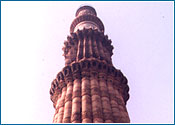
The
highest stone tower in India, the Qutub Minar was built by Qutbuddin Aibak,
the viceroy of Mohammed Ghori in 1192. It was built to celebrate Ghori's victory
over the Rajputs. The tower and the victory are very significant, because both
heralded the birth of a new dynasty - Slave Dynasty. And it laid the foundations
of the Delhi Sultanate. And the rest, as one would put it after witnessing this
monumental tower, was history. The Minar is a five-storey building with a height
of 72.5 metres. The first storey of the Qutb Minar was completed in the lifetime
of Qutbuddin. His son-in-law and successor, Iltumush, added the next three storeys.
Within the complex, is the famous Iron Pillar which has stood for millennia
without rusting, Quwwat-ul-Islam, the first mosque built in India, and the Alai
Darwaza, the gateway to the complex erected by Alauddin Khilji. The entry to
the Minar has been closed, after the tower became infamous for the several suicides
that were committed here. Qutb Minar is a successful tribute to architecture,
as it captures one's attention by its sheer mass appeal. Even on close encounter,
the attention lingers, owing to the delicate and almost ethereal carvings.

 Iron
Pillar
Iron
Pillar

The
7.2 metre high pillar, standing within the Qutb Minar complex, is a proof of
India's advanced knowledge of metallurgy 2000 years ago. For it continues to
stand, even today, rust-free. The pillar was erected sometime between the 4th
and 5th century AD as a Dhavaja-stambha (flagpole) of a Vishnu temple. It was
erected in memory of King Chandragupta Vikramamditya who ruled from 375 to 413
AD. The Sanskrit inscriptions on the pillar record these facts. Unbelievable,
considering today, even the spoons in our kitchens cannot guarantee this kind
of an immortality after centuries of scientific progress! Another thing one
has to do after laying one's sight on this pillar is, to go and give it a bear
hug. Besides the metallurgic excellence, it is believed that hugging the pillar
will make all of one's wishes come true. So… go, see and hug!

 Sultan
Ghari's Tomb
Sultan
Ghari's Tomb
Sultan Ghari's Tomb is the first Islamic tomb built in India. It was built by
emperor Iltumush, in 1231, as a tomb for his son and heir Nasiruddin Muhammad
after he was slain in battle. The tomb is more like a fortress with huge walls
and bastions. Characteristic of the architecture of the Slave dynasty, the tomb
as such was made of pillars and stones taken from the temples nearby. The tomb
is an octagonal platform standing on a raised courtyard and forms the roof of
the crypt. The tomb is situated bang in the middle of Vasant Kunj. It is located
on the road from Andheri to Delhi Airport.

 India
Gate
India
Gate

This
solemn monument was built in memory of the 90,000 Indian soldiers who died in
World War I. It was built in 1931, designed by Lutyens, and was originally called
the All India War Memorial. The names of the soldiers are inscribed on the walls
of the arc of the gate. Later in 1971, an eternal flame was lit here in memory
of the unknown soldiers who died in the 1971 Indo-Pakistan war. India Gate stands
at the end of Rajpath, and is a popular picnic site especially during hot summer
evenings. At night, the Gate is brightly lit and the fountains near the Gate
are lit with coloured lights. The sight is delightful.

 Rashtrapati
Bhavan
Rashtrapati
Bhavan

The
house that houses the President of India and the house that boasts of having
welcomed the most powerful men in history. The Rashtrapati Bhavan was designed
by Edwin Lutyens and built in 1931, to be the central point of the British power
in Delhi. Originally called the Viceroy's House, the Rashtrapati Bhavan covers
an area of 4.5 acres of land. It has 340 rooms, 37 salons, 74 lobbies and loggias,
18 staircases and 37 fountains. The most magnificent room in the Rashtrapati
Bhavan is the Durbar Hall, which lies directly beneath the main dome. All important
Indian State and Official ceremonies are held here. To the west, is the famous
and beautifully landscaped Mughal Gardens, designed after the terraced gardens
the Mughals built in Kashmir. The garden is famous as the 'Butterfly Garden'
for the numerous butterflies that visit the varied flowers. The garden is open
to the public in February.

 Jantar
Mantar
Jantar
Mantar
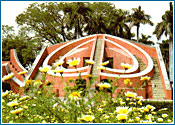
If
you are an astronomy buff then Delhi has something for you. Jantar Mantar -
the 18th century observatory. Sawai Jai Singh II built it in 1724 when commissioned
by the then Mughal emperor Muhammad Shah. The Jantar Mantar in Delhi is one
of the five observatories that Jai Singh built in Jaipur, Varanasi, Ujjain and
Mathura. A keen astronomer the Maharaja felt that the existing observatories
did not provide accurate information and so he built the larger and more accurate
instruments. And this is a piece of engineering and scientific brilliance. The
Jantar Mantar, however today, is a popular place for staging dharnas and protests.
One is sure to come across at least one group of protestors while visiting the
magnificent monument. Well, they are worth a visit too! There are buses, auto
rickshaws and taxis, which can take one to the monument from any part of the
city. And if one feels more comfortable in a conducted tour then there are several
tourism offices that conduct them.

 Firoz
Shah Kotla
Firoz
Shah Kotla
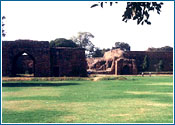
Firoz
Shah Kotla was the citadel of the city Firozabad, that Firoz Shah Tuglaq built
in 1354. Within the complex of the Firoz Shah Kotla complex is the spectacular
Ashoka Pillar and the Jama Masjid. The Ashoka Pillar was erected by emperor
Ashoka. The monolith is over 12.8 metres high and weighs around 27 tonnes. The
inscriptions on the pillar helped in deciphering the ancient Brahmi script.
The Jama Masjid was at one time Delhi's largest mosque. Legend has it that Tamburlaine,
the Mongol conqueror who ransacked Delhi in 1398, came for his Friday prayers
here. So the mosque is definitely a must see for all those who want a rendezvous
with the great conqueror!

 Tughlaqabad
Fort
Tughlaqabad
Fort
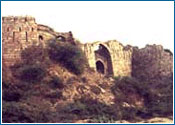
The
spectacular fort of Tughlaqabad was built by Ghiyasuddin Tuglaq and was completed
in four years. It was built to guard the city against the attacks of the Mongols
from Central Asia. It was so sturdy that it has withstood the ravages of time
and still stands today, all along the 6.5 km perimeter. To the right of the
main entrance are the ruins of Vijay Mandal (Tower of Victory). Towards the
west of the citadel, is a 15.5 metre deep water tank nicknamed Jahannum ka Rasta
or the Road to Hell. Even the monkeys that inhabit the fort keep away from the
tank. Soon after its construction, Tughlaqabad was destined to be abandoned.
Legend has it that Nizamuddin Auliya, a Sufi saint, cursed Ghiyasuddin that
Tughlaqabad would never prosper after the emperor quarreled with the saint.
The curse did come true with Ghiyasuddin's alleged murder, when a pavilion erected
in his honour crashed on him. With Ghiyasuddin's death came the tragic end of
a city, which could have otherwise prospered.

 Coronation
Durbar
Coronation
Durbar
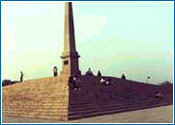
Situated
in the north of Old Delhi, the Coronation Durbar site is of historical significance.
It was here that King George V was declared the emperor of India in 1911. Imagine
the Maharajas, the elephants and the royal women in their fineries. It must
have been a grand sight! An obelisk stands significantly on the field. It marks
the site where the royal durbars were held between 1877 and 1903. The pride
of this place is a 15 metre high statue of King George V that rises above the
Acacia trees. Several marble statues of Imperial dignitaries lie in the field.
Visiting the site of the Durbar is definitely a nostalgic journey especially
for all the fans of the Raj.

 Ghazi-ud-Din's
Madrasa
Ghazi-ud-Din's
Madrasa
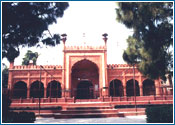
The
imposing red sandstone Madrasa was built in 1692. It was Delhi's famous and
most sought after Madrasa. In 1824, it came to be known as Anglo-Arabic School
after the British introduced English in the syllabus of the Madrasa. Though
part of Shahjanabad, the Madrasa lies beyond its walls, near Ajmeri Gate. Ghazi-ud-Din's
tomb and mosque lie beside the Madrasa. Ghazi-ud-Din Khan was a prominent courtier
during the reign of the sixth Mughal emperor Aurangazeb. The two-storey building
still serves as a college. Earlier called the Delhi College, now it is the Zakir
Hussain College. To get to the Madrasa one has to go through crowded narrow
alleys. But it is exciting especially on a cycle rickshaw, the one way to taste
the flavour of Delhi. The Madrasa is definitely worth seeing, especially since
it is one of the few surviving Madrasas in the capital.

 Teen
Murti Bhavan
Teen
Murti Bhavan
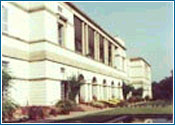
The
Teen Murti Bhavan housed the first Prime Minister of India, Jawaharlal Nehru.
It was designed by Robert Tor Russel, the architect of Connaught Place, and
the Eastern and Western Courts on Janpath. The Bhavan was originally the residence
of the Commander-in-Chief of the British Forces in India. However, after independence
the house was taken over as the residence of Jawaharlal Nehru. And on his death,
the house was converted into a national memorial comprising a library and a
museum. The library is one of the finest ones for information on modern Indian
history. The house gets its name after the Teen Murti (three statues) Memorial,
which stands on its extensive grounds. The memorial was built in memory of the
Indian soldiers who perished in World War I. The Bhavan is closed to public
on Mondays and on all public holidays.

 Khuni
Darwaza
Khuni
Darwaza

Khuni
Darwaza (blood soaked gate), is a huge gateway on Bahadur Shah Zafar Marg. It
was built by Sher Shah Suri as one of the gates to his city. If you are wondering
about the rather gruesome name, it is because the Gate has a bloody history
to it. In the battle to the throne of Delhi, the Mughal emperor Aurangazeb,
beheaded his brother Dara Shikoh. And as a grand finale he had the dismembered
head hung on the gate. And it is also here that the British assassinated the
two sons and the grandson of Bahadhur Shah Zafar. Their bodies were hung on
the gateway, to be displayed to the public as a warning against any kind of
a mutiny. And since horror is in itself fascinating, the gate is worth a see!

 Jamali
Kamali
Jamali
Kamali
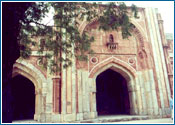
A
gravelled path, little away from Qutb Minar leads to Jamlai Kamali Masjid and
Tomb. It is set within a beautiful park, where one can find numerous birds,
especially peacocks, in the mornings. The tomb is enclosed within a ten feet
wall. The mosque has a quiet air of elegance and simplicity, with the simple
lines that mark its exterior. It is a flat roofed chamber, with a highly decorative
ceiling, characteristic of Mughal architecture. Jamali is the pseudonym of Sheik
Fazullah, a saint and poet, who was the favourite of Sultan Sikander Lodi and
Emperor Humayun. His tomb lies beside the mosque, which was built under his
guidance. However, no one really knows who Kamali was. Interestingly, the tomb
is first of the historical monuments that has been restored in the capital.
The tomb is usually closed to the public. However, the park surrounding the
tomb is definitely worth a visit for its serene atmosphere.

 Hauz
Khas
Hauz
Khas
Huaz Khas (Royal Tank), is a village by itself, with several boutiques, art
galleries and restaurants. At the core of the village is the tank which was
made by Alauddin Khilji in 1300, to supply water to his city, Siri. Later, Firoz
Shah Tuglaq repaired it and built a Madrasa or college along its bank. The buildings
definitely worth a visit are the Madrasa, Feroze Shah's tomb and the ruins of
a small mosque. The two-storey Madrasa is fascinating for its clever architecture.
The lower floor is at the same level as the tank, and the first floor was at
the ground level, promising cool breezes throughout the year. Hot afternoons
may not have been so sleepy afterall for the scholars!


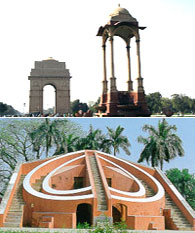
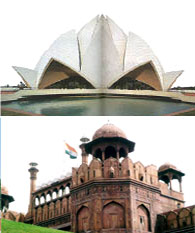
 The
Red Fort, with a circumference of over 2.2 kilometers, was laid out by the banks
of the Yamuna river in the 17th century. The Mughal emperor Shajahan built it
with the ambition of concentrating the Mughal power in one monument. Monument
is perhaps not the right word. A mini-city is more like it. Unfortunately for
the emperor, before he could move his capital from Agra to Shahjahanabad in
Delhi, he was taken a political prisoner by his son Aurangazeb. The fort is
a delight to one's imagination. Imagine the Naqqar Khana (Drum room) also called
Naubat Khana (Welcome Room), where once drums loudly heralded the arrival of
the emperor and the Diwan-e-Am (Hall of Public Audience) resounded with the
incantations of the people. Amazing, isn't it? There's more to see - Mumtaz
Mahal, Rang Mahal (Palace of Colours), Khas Mahal (Emperor's Palace), Diwan-e
Khas (Hall of Private Audience), the Hammam (bathing area) and Shah Burj.
The
Red Fort, with a circumference of over 2.2 kilometers, was laid out by the banks
of the Yamuna river in the 17th century. The Mughal emperor Shajahan built it
with the ambition of concentrating the Mughal power in one monument. Monument
is perhaps not the right word. A mini-city is more like it. Unfortunately for
the emperor, before he could move his capital from Agra to Shahjahanabad in
Delhi, he was taken a political prisoner by his son Aurangazeb. The fort is
a delight to one's imagination. Imagine the Naqqar Khana (Drum room) also called
Naubat Khana (Welcome Room), where once drums loudly heralded the arrival of
the emperor and the Diwan-e-Am (Hall of Public Audience) resounded with the
incantations of the people. Amazing, isn't it? There's more to see - Mumtaz
Mahal, Rang Mahal (Palace of Colours), Khas Mahal (Emperor's Palace), Diwan-e
Khas (Hall of Private Audience), the Hammam (bathing area) and Shah Burj.  Humayun's
Tomb is probably one of the most innovative and experimental monuments of its
time, incorporating within it Indo-Islamic architectural styles. Hamida Bhanu
Begum (Haji Begum), Humayun's grieving widow built it in 1565-66. She is said
to have spent 15 lakh rupees on it. Humayun's Tomb shows a very remarkable Persian
influence, and art historians conjecture that this influence could probably
have its origin in Humayun's exile in Persia. The tomb, typical of a Persian
design, is a square building cut off at its corners to make it octagonal. It
started a whole new form of architecture, where tombs were built in the centre
of a four-portioned garden.
Humayun's
Tomb is probably one of the most innovative and experimental monuments of its
time, incorporating within it Indo-Islamic architectural styles. Hamida Bhanu
Begum (Haji Begum), Humayun's grieving widow built it in 1565-66. She is said
to have spent 15 lakh rupees on it. Humayun's Tomb shows a very remarkable Persian
influence, and art historians conjecture that this influence could probably
have its origin in Humayun's exile in Persia. The tomb, typical of a Persian
design, is a square building cut off at its corners to make it octagonal. It
started a whole new form of architecture, where tombs were built in the centre
of a four-portioned garden.  In
1538, the Mughal emperor Humayun laid the foundations of his city named Dinpanah,
or the Refuge of the Faithful. The inner citadel of this city is today called
Purana Qila or the Old Fort. An old fort, it is! One can almost smell the ancient
stories oozing from the corners of the fort. The site of the fort was also Indraprasta,
the capital of the famed warriors of the Mahabharata, the Pandavas. Excavations
near the eastern wall of the fort reveal that the site had been occupied since
1000 B.C. Archaeologists found painted grey ware pottery and other remains,
which date back to the Mahabharata. The Purana Qila has three gates - Humayun
Darwaza, Talaqi Darwaza and Bara Darwaza. The present entrance is the Bara Darwaza,
an imposing red sandstone gate on the western wall. Inside the Purana Qila is
the Sher Mandal, a two-storied octagonal pavilion in red sandstone, built by
Sher Shah. Humayun used it as a library after he captured the fort. However,
the Mandal is tragic, since it was here where the emperor is said to have tripped
on its tortuous stairs and tumbled to his death in 1556.
In
1538, the Mughal emperor Humayun laid the foundations of his city named Dinpanah,
or the Refuge of the Faithful. The inner citadel of this city is today called
Purana Qila or the Old Fort. An old fort, it is! One can almost smell the ancient
stories oozing from the corners of the fort. The site of the fort was also Indraprasta,
the capital of the famed warriors of the Mahabharata, the Pandavas. Excavations
near the eastern wall of the fort reveal that the site had been occupied since
1000 B.C. Archaeologists found painted grey ware pottery and other remains,
which date back to the Mahabharata. The Purana Qila has three gates - Humayun
Darwaza, Talaqi Darwaza and Bara Darwaza. The present entrance is the Bara Darwaza,
an imposing red sandstone gate on the western wall. Inside the Purana Qila is
the Sher Mandal, a two-storied octagonal pavilion in red sandstone, built by
Sher Shah. Humayun used it as a library after he captured the fort. However,
the Mandal is tragic, since it was here where the emperor is said to have tripped
on its tortuous stairs and tumbled to his death in 1556. Safdarjung's
Tomb is the last of the enclosed garden tombs in the tradition of Humayun's
tomb. It was built in 1753-54, for Safdarjung, the Prime Minister of Muhammad
Shah, the Mughal emperor between 1719-48. Marble was allegedly stripped from
other tombs to build Safdarjung's tomb. Now that speaks volumes for the kind
of power Safdarjung must have wielded during his rule! The tomb has several
smaller pavilions - Jangli Mahal (Palace in the Woods), Moti Mahal (Pearl Palace)
and Badshah Pasand (King's Favourite) - the interiors of which have been beautifully
ornamented in the typical Mughal style. The Archaeological Survey of India maintains
a library over the main gateway, and it is a haven for all bookworms and history
buffs.
Safdarjung's
Tomb is the last of the enclosed garden tombs in the tradition of Humayun's
tomb. It was built in 1753-54, for Safdarjung, the Prime Minister of Muhammad
Shah, the Mughal emperor between 1719-48. Marble was allegedly stripped from
other tombs to build Safdarjung's tomb. Now that speaks volumes for the kind
of power Safdarjung must have wielded during his rule! The tomb has several
smaller pavilions - Jangli Mahal (Palace in the Woods), Moti Mahal (Pearl Palace)
and Badshah Pasand (King's Favourite) - the interiors of which have been beautifully
ornamented in the typical Mughal style. The Archaeological Survey of India maintains
a library over the main gateway, and it is a haven for all bookworms and history
buffs.  The
highest stone tower in India, the Qutub Minar was built by Qutbuddin Aibak,
the viceroy of Mohammed Ghori in 1192. It was built to celebrate Ghori's victory
over the Rajputs. The tower and the victory are very significant, because both
heralded the birth of a new dynasty - Slave Dynasty. And it laid the foundations
of the Delhi Sultanate. And the rest, as one would put it after witnessing this
monumental tower, was history. The Minar is a five-storey building with a height
of 72.5 metres. The first storey of the Qutb Minar was completed in the lifetime
of Qutbuddin. His son-in-law and successor, Iltumush, added the next three storeys.
Within the complex, is the famous Iron Pillar which has stood for millennia
without rusting, Quwwat-ul-Islam, the first mosque built in India, and the Alai
Darwaza, the gateway to the complex erected by Alauddin Khilji. The entry to
the Minar has been closed, after the tower became infamous for the several suicides
that were committed here. Qutb Minar is a successful tribute to architecture,
as it captures one's attention by its sheer mass appeal. Even on close encounter,
the attention lingers, owing to the delicate and almost ethereal carvings.
The
highest stone tower in India, the Qutub Minar was built by Qutbuddin Aibak,
the viceroy of Mohammed Ghori in 1192. It was built to celebrate Ghori's victory
over the Rajputs. The tower and the victory are very significant, because both
heralded the birth of a new dynasty - Slave Dynasty. And it laid the foundations
of the Delhi Sultanate. And the rest, as one would put it after witnessing this
monumental tower, was history. The Minar is a five-storey building with a height
of 72.5 metres. The first storey of the Qutb Minar was completed in the lifetime
of Qutbuddin. His son-in-law and successor, Iltumush, added the next three storeys.
Within the complex, is the famous Iron Pillar which has stood for millennia
without rusting, Quwwat-ul-Islam, the first mosque built in India, and the Alai
Darwaza, the gateway to the complex erected by Alauddin Khilji. The entry to
the Minar has been closed, after the tower became infamous for the several suicides
that were committed here. Qutb Minar is a successful tribute to architecture,
as it captures one's attention by its sheer mass appeal. Even on close encounter,
the attention lingers, owing to the delicate and almost ethereal carvings.
 The
7.2 metre high pillar, standing within the Qutb Minar complex, is a proof of
India's advanced knowledge of metallurgy 2000 years ago. For it continues to
stand, even today, rust-free. The pillar was erected sometime between the 4th
and 5th century AD as a Dhavaja-stambha (flagpole) of a Vishnu temple. It was
erected in memory of King Chandragupta Vikramamditya who ruled from 375 to 413
AD. The Sanskrit inscriptions on the pillar record these facts. Unbelievable,
considering today, even the spoons in our kitchens cannot guarantee this kind
of an immortality after centuries of scientific progress! Another thing one
has to do after laying one's sight on this pillar is, to go and give it a bear
hug. Besides the metallurgic excellence, it is believed that hugging the pillar
will make all of one's wishes come true. So… go, see and hug!
The
7.2 metre high pillar, standing within the Qutb Minar complex, is a proof of
India's advanced knowledge of metallurgy 2000 years ago. For it continues to
stand, even today, rust-free. The pillar was erected sometime between the 4th
and 5th century AD as a Dhavaja-stambha (flagpole) of a Vishnu temple. It was
erected in memory of King Chandragupta Vikramamditya who ruled from 375 to 413
AD. The Sanskrit inscriptions on the pillar record these facts. Unbelievable,
considering today, even the spoons in our kitchens cannot guarantee this kind
of an immortality after centuries of scientific progress! Another thing one
has to do after laying one's sight on this pillar is, to go and give it a bear
hug. Besides the metallurgic excellence, it is believed that hugging the pillar
will make all of one's wishes come true. So… go, see and hug! This
solemn monument was built in memory of the 90,000 Indian soldiers who died in
World War I. It was built in 1931, designed by Lutyens, and was originally called
the All India War Memorial. The names of the soldiers are inscribed on the walls
of the arc of the gate. Later in 1971, an eternal flame was lit here in memory
of the unknown soldiers who died in the 1971 Indo-Pakistan war. India Gate stands
at the end of Rajpath, and is a popular picnic site especially during hot summer
evenings. At night, the Gate is brightly lit and the fountains near the Gate
are lit with coloured lights. The sight is delightful.
This
solemn monument was built in memory of the 90,000 Indian soldiers who died in
World War I. It was built in 1931, designed by Lutyens, and was originally called
the All India War Memorial. The names of the soldiers are inscribed on the walls
of the arc of the gate. Later in 1971, an eternal flame was lit here in memory
of the unknown soldiers who died in the 1971 Indo-Pakistan war. India Gate stands
at the end of Rajpath, and is a popular picnic site especially during hot summer
evenings. At night, the Gate is brightly lit and the fountains near the Gate
are lit with coloured lights. The sight is delightful. The
house that houses the President of India and the house that boasts of having
welcomed the most powerful men in history. The Rashtrapati Bhavan was designed
by Edwin Lutyens and built in 1931, to be the central point of the British power
in Delhi. Originally called the Viceroy's House, the Rashtrapati Bhavan covers
an area of 4.5 acres of land. It has 340 rooms, 37 salons, 74 lobbies and loggias,
18 staircases and 37 fountains. The most magnificent room in the Rashtrapati
Bhavan is the Durbar Hall, which lies directly beneath the main dome. All important
Indian State and Official ceremonies are held here. To the west, is the famous
and beautifully landscaped Mughal Gardens, designed after the terraced gardens
the Mughals built in Kashmir. The garden is famous as the 'Butterfly Garden'
for the numerous butterflies that visit the varied flowers. The garden is open
to the public in February.
The
house that houses the President of India and the house that boasts of having
welcomed the most powerful men in history. The Rashtrapati Bhavan was designed
by Edwin Lutyens and built in 1931, to be the central point of the British power
in Delhi. Originally called the Viceroy's House, the Rashtrapati Bhavan covers
an area of 4.5 acres of land. It has 340 rooms, 37 salons, 74 lobbies and loggias,
18 staircases and 37 fountains. The most magnificent room in the Rashtrapati
Bhavan is the Durbar Hall, which lies directly beneath the main dome. All important
Indian State and Official ceremonies are held here. To the west, is the famous
and beautifully landscaped Mughal Gardens, designed after the terraced gardens
the Mughals built in Kashmir. The garden is famous as the 'Butterfly Garden'
for the numerous butterflies that visit the varied flowers. The garden is open
to the public in February. If
you are an astronomy buff then Delhi has something for you. Jantar Mantar -
the 18th century observatory. Sawai Jai Singh II built it in 1724 when commissioned
by the then Mughal emperor Muhammad Shah. The Jantar Mantar in Delhi is one
of the five observatories that Jai Singh built in Jaipur, Varanasi, Ujjain and
Mathura. A keen astronomer the Maharaja felt that the existing observatories
did not provide accurate information and so he built the larger and more accurate
instruments. And this is a piece of engineering and scientific brilliance. The
Jantar Mantar, however today, is a popular place for staging dharnas and protests.
One is sure to come across at least one group of protestors while visiting the
magnificent monument. Well, they are worth a visit too! There are buses, auto
rickshaws and taxis, which can take one to the monument from any part of the
city. And if one feels more comfortable in a conducted tour then there are several
tourism offices that conduct them.
If
you are an astronomy buff then Delhi has something for you. Jantar Mantar -
the 18th century observatory. Sawai Jai Singh II built it in 1724 when commissioned
by the then Mughal emperor Muhammad Shah. The Jantar Mantar in Delhi is one
of the five observatories that Jai Singh built in Jaipur, Varanasi, Ujjain and
Mathura. A keen astronomer the Maharaja felt that the existing observatories
did not provide accurate information and so he built the larger and more accurate
instruments. And this is a piece of engineering and scientific brilliance. The
Jantar Mantar, however today, is a popular place for staging dharnas and protests.
One is sure to come across at least one group of protestors while visiting the
magnificent monument. Well, they are worth a visit too! There are buses, auto
rickshaws and taxis, which can take one to the monument from any part of the
city. And if one feels more comfortable in a conducted tour then there are several
tourism offices that conduct them. Firoz
Shah Kotla was the citadel of the city Firozabad, that Firoz Shah Tuglaq built
in 1354. Within the complex of the Firoz Shah Kotla complex is the spectacular
Ashoka Pillar and the Jama Masjid. The Ashoka Pillar was erected by emperor
Ashoka. The monolith is over 12.8 metres high and weighs around 27 tonnes. The
inscriptions on the pillar helped in deciphering the ancient Brahmi script.
The Jama Masjid was at one time Delhi's largest mosque. Legend has it that Tamburlaine,
the Mongol conqueror who ransacked Delhi in 1398, came for his Friday prayers
here. So the mosque is definitely a must see for all those who want a rendezvous
with the great conqueror!
Firoz
Shah Kotla was the citadel of the city Firozabad, that Firoz Shah Tuglaq built
in 1354. Within the complex of the Firoz Shah Kotla complex is the spectacular
Ashoka Pillar and the Jama Masjid. The Ashoka Pillar was erected by emperor
Ashoka. The monolith is over 12.8 metres high and weighs around 27 tonnes. The
inscriptions on the pillar helped in deciphering the ancient Brahmi script.
The Jama Masjid was at one time Delhi's largest mosque. Legend has it that Tamburlaine,
the Mongol conqueror who ransacked Delhi in 1398, came for his Friday prayers
here. So the mosque is definitely a must see for all those who want a rendezvous
with the great conqueror! The
spectacular fort of Tughlaqabad was built by Ghiyasuddin Tuglaq and was completed
in four years. It was built to guard the city against the attacks of the Mongols
from Central Asia. It was so sturdy that it has withstood the ravages of time
and still stands today, all along the 6.5 km perimeter. To the right of the
main entrance are the ruins of Vijay Mandal (Tower of Victory). Towards the
west of the citadel, is a 15.5 metre deep water tank nicknamed Jahannum ka Rasta
or the Road to Hell. Even the monkeys that inhabit the fort keep away from the
tank. Soon after its construction, Tughlaqabad was destined to be abandoned.
Legend has it that Nizamuddin Auliya, a Sufi saint, cursed Ghiyasuddin that
Tughlaqabad would never prosper after the emperor quarreled with the saint.
The curse did come true with Ghiyasuddin's alleged murder, when a pavilion erected
in his honour crashed on him. With Ghiyasuddin's death came the tragic end of
a city, which could have otherwise prospered.
The
spectacular fort of Tughlaqabad was built by Ghiyasuddin Tuglaq and was completed
in four years. It was built to guard the city against the attacks of the Mongols
from Central Asia. It was so sturdy that it has withstood the ravages of time
and still stands today, all along the 6.5 km perimeter. To the right of the
main entrance are the ruins of Vijay Mandal (Tower of Victory). Towards the
west of the citadel, is a 15.5 metre deep water tank nicknamed Jahannum ka Rasta
or the Road to Hell. Even the monkeys that inhabit the fort keep away from the
tank. Soon after its construction, Tughlaqabad was destined to be abandoned.
Legend has it that Nizamuddin Auliya, a Sufi saint, cursed Ghiyasuddin that
Tughlaqabad would never prosper after the emperor quarreled with the saint.
The curse did come true with Ghiyasuddin's alleged murder, when a pavilion erected
in his honour crashed on him. With Ghiyasuddin's death came the tragic end of
a city, which could have otherwise prospered. Situated
in the north of Old Delhi, the Coronation Durbar site is of historical significance.
It was here that King George V was declared the emperor of India in 1911. Imagine
the Maharajas, the elephants and the royal women in their fineries. It must
have been a grand sight! An obelisk stands significantly on the field. It marks
the site where the royal durbars were held between 1877 and 1903. The pride
of this place is a 15 metre high statue of King George V that rises above the
Acacia trees. Several marble statues of Imperial dignitaries lie in the field.
Visiting the site of the Durbar is definitely a nostalgic journey especially
for all the fans of the Raj.
Situated
in the north of Old Delhi, the Coronation Durbar site is of historical significance.
It was here that King George V was declared the emperor of India in 1911. Imagine
the Maharajas, the elephants and the royal women in their fineries. It must
have been a grand sight! An obelisk stands significantly on the field. It marks
the site where the royal durbars were held between 1877 and 1903. The pride
of this place is a 15 metre high statue of King George V that rises above the
Acacia trees. Several marble statues of Imperial dignitaries lie in the field.
Visiting the site of the Durbar is definitely a nostalgic journey especially
for all the fans of the Raj.  The
imposing red sandstone Madrasa was built in 1692. It was Delhi's famous and
most sought after Madrasa. In 1824, it came to be known as Anglo-Arabic School
after the British introduced English in the syllabus of the Madrasa. Though
part of Shahjanabad, the Madrasa lies beyond its walls, near Ajmeri Gate. Ghazi-ud-Din's
tomb and mosque lie beside the Madrasa. Ghazi-ud-Din Khan was a prominent courtier
during the reign of the sixth Mughal emperor Aurangazeb. The two-storey building
still serves as a college. Earlier called the Delhi College, now it is the Zakir
Hussain College. To get to the Madrasa one has to go through crowded narrow
alleys. But it is exciting especially on a cycle rickshaw, the one way to taste
the flavour of Delhi. The Madrasa is definitely worth seeing, especially since
it is one of the few surviving Madrasas in the capital.
The
imposing red sandstone Madrasa was built in 1692. It was Delhi's famous and
most sought after Madrasa. In 1824, it came to be known as Anglo-Arabic School
after the British introduced English in the syllabus of the Madrasa. Though
part of Shahjanabad, the Madrasa lies beyond its walls, near Ajmeri Gate. Ghazi-ud-Din's
tomb and mosque lie beside the Madrasa. Ghazi-ud-Din Khan was a prominent courtier
during the reign of the sixth Mughal emperor Aurangazeb. The two-storey building
still serves as a college. Earlier called the Delhi College, now it is the Zakir
Hussain College. To get to the Madrasa one has to go through crowded narrow
alleys. But it is exciting especially on a cycle rickshaw, the one way to taste
the flavour of Delhi. The Madrasa is definitely worth seeing, especially since
it is one of the few surviving Madrasas in the capital.  The
Teen Murti Bhavan housed the first Prime Minister of India, Jawaharlal Nehru.
It was designed by Robert Tor Russel, the architect of Connaught Place, and
the Eastern and Western Courts on Janpath. The Bhavan was originally the residence
of the Commander-in-Chief of the British Forces in India. However, after independence
the house was taken over as the residence of Jawaharlal Nehru. And on his death,
the house was converted into a national memorial comprising a library and a
museum. The library is one of the finest ones for information on modern Indian
history. The house gets its name after the Teen Murti (three statues) Memorial,
which stands on its extensive grounds. The memorial was built in memory of the
Indian soldiers who perished in World War I. The Bhavan is closed to public
on Mondays and on all public holidays.
The
Teen Murti Bhavan housed the first Prime Minister of India, Jawaharlal Nehru.
It was designed by Robert Tor Russel, the architect of Connaught Place, and
the Eastern and Western Courts on Janpath. The Bhavan was originally the residence
of the Commander-in-Chief of the British Forces in India. However, after independence
the house was taken over as the residence of Jawaharlal Nehru. And on his death,
the house was converted into a national memorial comprising a library and a
museum. The library is one of the finest ones for information on modern Indian
history. The house gets its name after the Teen Murti (three statues) Memorial,
which stands on its extensive grounds. The memorial was built in memory of the
Indian soldiers who perished in World War I. The Bhavan is closed to public
on Mondays and on all public holidays. Khuni
Darwaza (blood soaked gate), is a huge gateway on Bahadur Shah Zafar Marg. It
was built by Sher Shah Suri as one of the gates to his city. If you are wondering
about the rather gruesome name, it is because the Gate has a bloody history
to it. In the battle to the throne of Delhi, the Mughal emperor Aurangazeb,
beheaded his brother Dara Shikoh. And as a grand finale he had the dismembered
head hung on the gate. And it is also here that the British assassinated the
two sons and the grandson of Bahadhur Shah Zafar. Their bodies were hung on
the gateway, to be displayed to the public as a warning against any kind of
a mutiny. And since horror is in itself fascinating, the gate is worth a see!
Khuni
Darwaza (blood soaked gate), is a huge gateway on Bahadur Shah Zafar Marg. It
was built by Sher Shah Suri as one of the gates to his city. If you are wondering
about the rather gruesome name, it is because the Gate has a bloody history
to it. In the battle to the throne of Delhi, the Mughal emperor Aurangazeb,
beheaded his brother Dara Shikoh. And as a grand finale he had the dismembered
head hung on the gate. And it is also here that the British assassinated the
two sons and the grandson of Bahadhur Shah Zafar. Their bodies were hung on
the gateway, to be displayed to the public as a warning against any kind of
a mutiny. And since horror is in itself fascinating, the gate is worth a see!
 A
gravelled path, little away from Qutb Minar leads to Jamlai Kamali Masjid and
Tomb. It is set within a beautiful park, where one can find numerous birds,
especially peacocks, in the mornings. The tomb is enclosed within a ten feet
wall. The mosque has a quiet air of elegance and simplicity, with the simple
lines that mark its exterior. It is a flat roofed chamber, with a highly decorative
ceiling, characteristic of Mughal architecture. Jamali is the pseudonym of Sheik
Fazullah, a saint and poet, who was the favourite of Sultan Sikander Lodi and
Emperor Humayun. His tomb lies beside the mosque, which was built under his
guidance. However, no one really knows who Kamali was. Interestingly, the tomb
is first of the historical monuments that has been restored in the capital.
The tomb is usually closed to the public. However, the park surrounding the
tomb is definitely worth a visit for its serene atmosphere.
A
gravelled path, little away from Qutb Minar leads to Jamlai Kamali Masjid and
Tomb. It is set within a beautiful park, where one can find numerous birds,
especially peacocks, in the mornings. The tomb is enclosed within a ten feet
wall. The mosque has a quiet air of elegance and simplicity, with the simple
lines that mark its exterior. It is a flat roofed chamber, with a highly decorative
ceiling, characteristic of Mughal architecture. Jamali is the pseudonym of Sheik
Fazullah, a saint and poet, who was the favourite of Sultan Sikander Lodi and
Emperor Humayun. His tomb lies beside the mosque, which was built under his
guidance. However, no one really knows who Kamali was. Interestingly, the tomb
is first of the historical monuments that has been restored in the capital.
The tomb is usually closed to the public. However, the park surrounding the
tomb is definitely worth a visit for its serene atmosphere.